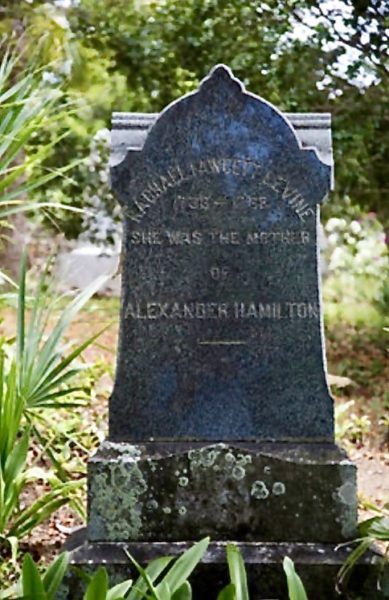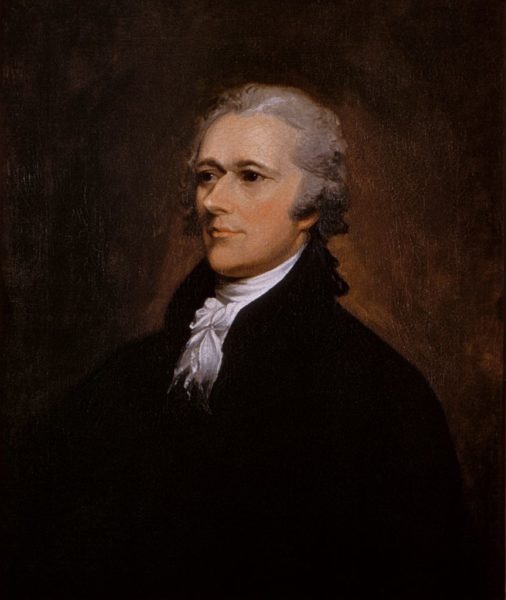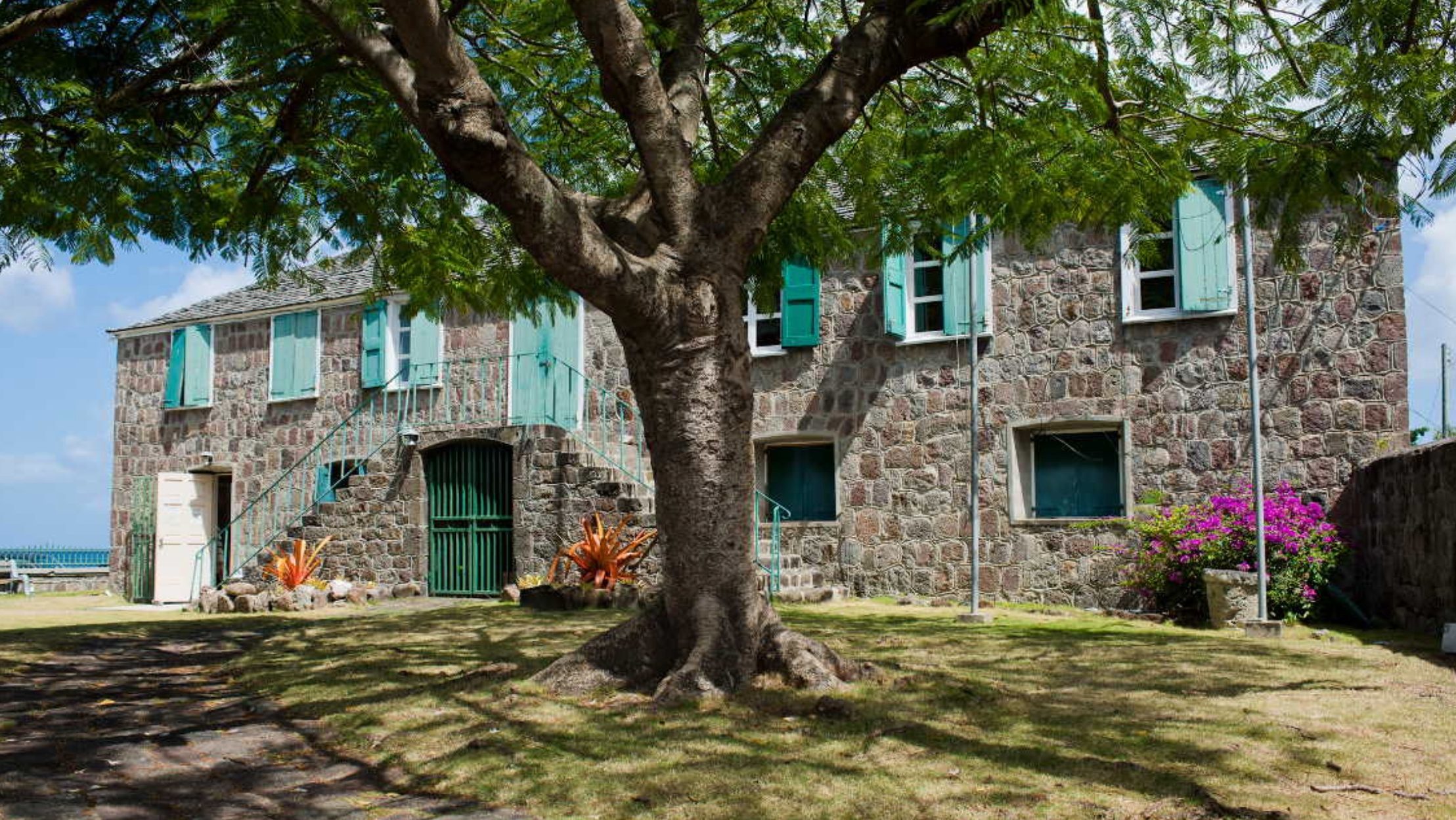This two-story Georgian style building, in Charlestown, Nevis Island, US Virgin Islands was the birthplace of Alexander Hamilton. (Photo courtesy of NevisIsland.com)
[Updated 4 February 2021]
The theme this week is a SMALL WORLD. In researching the American Revolutionary period in Beaufort last week, I came across a small detail that caught my attention. In the years leading up to our Declaration of Independence from Great Britain, Beaufort was a thriving shipping port. One of the prominent merchants operating along the bay in Beaufort was Peter Lavien (1746 – 1781). He moved to the town in 1765 from Sankt Croix, then under Danish rule. (Today, St. Croix is part of the US Virgin Islands.) Unfortunately, a pesky revolution began to wreak havoc on his business, and he became a Tory, a loyalist to Britain’s side of the conflict. He spent over ten years in Beaufort before moving to Savannah, GA. The small world connection I discovered involves his younger half-brother. The brother eventually also moved to the Colonies from Sankt Croix but landed in Boston in 1772. His initials were A.H. Today, I’m going to tell you a bit more about the families of both brothers.
The first fact
Peter was born to John Lavien (1717 – 1771) and his wife Rachel Faucette (1729 – 1768) in 1746. They had been married the year before. It seems John married Rachel for her money. Her father died in 1744, leaving her with “a snug fortune.” John was not wealthy but posed to get permission for her hand from her recently widowed mother, Mary Uppington Faucette. Soon after Peter’s birth, life became unbearable for Rachel. In 1750 she refused to live with John anymore and took up residence with a single man. She was accused by her husband of infidelity, was convicted (twice), and was jailed! [Newton] We know, as best we can, that she was indeed adulterous because of extensive court records that have survived. We don’t know, and probably never will, whether she was driven away from her husband by his actions.
Rachel was released from prison after eight months and fled to Nevis Island in the British West Indies. There she met and fell in love with James A. Hamilton. They had two sons together, James Jr. Hamilton (1753 – 1786) and Alexander Hamilton (1755 – 1804). Unfortunately, the sons were born out of wedlock, a fact that would complicate their lives for quite a while. When John Lavien eventually divorced Rachel in 1759, she was not allowed under Danish law to remarry.
The illegitimate son above is THAT Alexander Hamilton, military aide to General Washington, author of most of the Federalist Papers, first Secretary of Treasury, and the subject of Hamilton: An American Musical.
When I first saw Alexander Hamilton mentioned in Dr. Rowland’s book, all in a historical Beaufort context, I raced right past it. Then I realized he was referring to THE Alexander Hamilton, one of our Founding Fathers! [Richard Brandon Morris, 1973]
It is a small world. We now live a short distance from where Alexander Hamilton’s half-brother once lived. Sorry to say there is no indication that Alexander ever visited Beaufort or even South Carolina.
Peter Lavien – the Tory
As mentioned earlier, Peter Lavien moved to Beaufort in 1765 at the age of 18. According to several sources, he became quite wealthy as a shipping merchant. When his mother Rachel died in 1768, he was the only legitimate heir amongst her three sons. Peter went back to Sankt Croix in 1769 to take possession of his inheritance from his mother’s estate. I mentioned smuggling in last week’s article about the early years of the American Revolution. Peter was Beaufort’s most prominent Tory smuggler [Rowland, pg. 244.] As the war progressed, he moved to Savannah in 1777 and lived with his daughter and son-in-law, Joanna and John C. Lucena. Peter Lavien died in Savannah in 1781. His property in Beaufort was disposed of by his former partner’s stepson, John Kean. Kean was a patriot and eventually became a nationally prominent politician in the late 18th century [Rowland, Pages 244-245.]
Rachel Faucette Lavien & James A. Hamilton
Rachel’s life with James Hamilton was generally normal for the next 15 years. They raised their two sons as husband and wife in Christiansted, Sankt Croix, where she died in 1768. A friend of Rachel’s bought her family books and returned them to Alexander, an orphan at age 13. It’s unclear if their father had the means or ability to adopt them formally. The Hamilton brothers were soon separated, and Thomas Stevens, an import-export merchant, primarily raised Alexander. Through community leaders’ generosity, he was sent to North America for his education, arriving in October 1772, at age 17. The 34 books Alexander got from his mother’s estate were instrumental in furthering his education. Within two years, he had graduated from King’s College, now Columbia College within Columbia University.
By 1771, John Lavien and his second family had all passed away on Sankt Croix.

Alexander Hamilton – the Patriot
I’ve listed a few of many great books about Alexander Hamilton in the sources below. To have risen from this kind of childhood, in that place of sugar plantations and poverty to a Founding Father of the United States, is just remarkable. He kept in touch with his biological father after his mother’s death and was aware of his half-brother’s life in South Carolina, then Georgia. When Alexander Hamilton heard of Peter’s death, he wrote to his wife, Elizabeth Schuyler Hamilton,
“Engrossed by our own immediate concerns, I omitted to tell you of a disagreeable piece of intelligence I have received from a gentleman of Georgia. He tells me of the death of my brother Levine [sic]. You know the circumstances that abate my distress, yet my heart acknowledges the rights of a brother. He dies rich but has disposed of the bulk of his fortune to strangers. I am told he has left me a legacy. I did not inquire how much.”
Alexander Hamilton and his wife, Elizabeth Schuyler (1757 – 1854), had eight children. All lived to adulthood, though his oldest son Philip died in a duel at the age of 19. The story of Alexander’s death is a more extended tale. The short version is, he was killed in a duel, with Aaron Burr, in 1804. His wife spent the next 50 years preserving her husband’s legacy. Both are buried in Trinity Churchyard in Manhattan, NY.
Given the circumstances of his mother’s early marriage and indiscretions, I wondered what Alexander Hamilton thought of her. In 1834, John C. Hamilton published a biography on his father. In it, he wrote this about his father,
“…the traces of her character remained vividly impressed upon his memory. He recollected her with inexpressible fondness and often spoke of her as a woman of superior intellect, highly cultivated, of elevated and generous sentiments, and of unusual elegance of person and manner.”

Epilogue
There is no direct Sams connection this week, just a “small world” trace to Beaufort. I find it interesting that the Sams shared a familiar hometown with Alexander Hamilton’s half-brother. And who knows, maybe Alexander Hamilton was the talk of the town even amongst some Sams when our nation was in its nascent years.
Recently, Peter Lavien’s will was discovered at Liberty Hall Museum at Kean University, Union, NJ. We now know that the ‘legacy’ left to each of his brothers (Alexander and James Hamilton) was one hundred fifty pounds sterling, the equivalent of $36,000 today.
For your awareness, the surname Lavien is sometimes spelled Lavein or Lavine. The name Rachel Faucette is sometimes spelled Rachael Fawcett.
Disclaimer: Just in the last two years, historian Michael Newton has discovered new source documents and published new information about Alexander Hamilton’s youth in the Caribbean. He has new evidence, for instance, about when Hamilton was born! History can be dynamic.
Sources
Recommended reading
Chernow, Ron (2005). Alexander Hamilton. Penguin Press. ISBN 978-0-14-303475-9. [This book was the inspiration for Hamilton: An American Musical]
Hamilton, Allan McLane (1910). The Intimate Life of Alexander Hamilton. Reprinted in 2016. [Written by his grandson using some original family records.]
Hamilton, John C. (1834). The Life of Alexander Hamilton
Newton, Michael E. (2019). Discovering Hamilton: New Discoveries in the Lives of Alexander Hamilton, His Family, Friends, and Colleagues, From Various Archives Around the World
References
Rowland, Lawrence S., Moore, Alexander, Rogers Jr., George C. – The History of Beaufort County, South Carolina, Volume I, 1514 – 1861, 1996.
Wikipedia, topics = Alexander Hamilton, Elizabeth Schuyler Hamilton, John Lavien, 10 Aug 2020.
#52Sams Week 32 – Small World
[print_posts post=”” pdf=”yes” print=”yes” word=”yes”]


